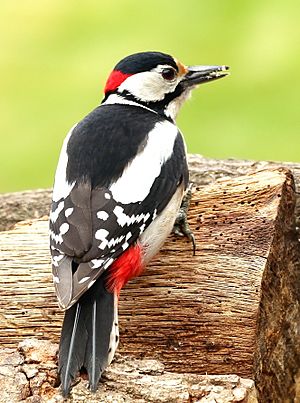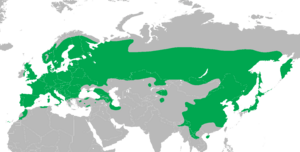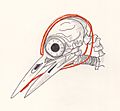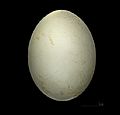Great spotted woodpecker facts for kids
The great spotted woodpecker (Dendrocopos major) is a cool bird with black and white feathers. It has a bright red patch on its lower belly. Male woodpeckers and young birds also have red marks on their neck or head.
This woodpecker lives across Europe, Asia, and parts of North Africa. Most of them stay in one place all year. But some from the north might fly to new places if they can't find enough food, like pine cones.
Some great spotted woodpeckers have even moved back to Ireland. A few have also been seen in North America. These birds are amazing at using their strong beaks. They chisel into trees to find food or to make holes for their nests. They also drum on trees to talk to each other and mark their territory. Their bodies are specially built to handle all that hammering!
You can find these birds in all kinds of forests. They eat many different things. They can get seeds out of pine cones. They also find insect larvae hidden inside trees. Sometimes, they even eat the chicks of other birds from their nests. They build their nests in holes they dig in trees. These holes are usually just lined with wood chips. After the young birds learn to fly, their parents feed them for about ten days.
Quick facts for kids Great spotted woodpecker |
|
|---|---|
 |
|
| Adult male Dendrocopos major pinetorum | |
| Conservation status | |
| Scientific classification | |
| Genus: |
Dendrocopos
|
| Species: |
major
|
 |
|
| Synonyms | |
|
Picus major Linnaeus, 1758 |
|
Contents
Great Spotted Woodpecker Facts
What They Look Like
Great spotted woodpeckers are medium-sized birds. They have striking black and white feathers. You can spot a red patch on their lower belly. Males and young birds have extra red spots. Males have a red patch on the back of their head. Young birds have a full red cap on their head. This helps you tell them apart from adults.
Where They Live
These woodpeckers live in many places around the world. You can find them across most of Europe and Asia. They also live in some parts of North Africa. They like to live in all kinds of forests and woodlands. They are very common in many areas.
Migration and Movement
Most great spotted woodpeckers stay in the same area all year. They are called "resident" birds. But sometimes, if there isn't enough food, like pine cones, some birds from the colder northern areas might fly south. This is called migration. They are looking for better places to find food. A few of these birds have even flown across the ocean! Some have moved back to Ireland, and a few have reached North America.
What They Eat
Great spotted woodpeckers eat a wide variety of foods. They are very clever at finding meals. They use their strong beaks to get seeds out of pine cones. They also dig into trees to find insect larvae. These larvae are like grubs living inside the wood. Sometimes, they even eat the eggs or young chicks of other birds. They also enjoy berries and nuts.
Life Cycle and Reproduction
These woodpeckers make their nests inside trees. They use their strong beaks to dig out a hole. They can make nests in both living and dead trees. The nest hole is usually quite simple. It's not lined with soft materials, just wood chips from their digging. The female lays her eggs inside this hole.
Once the eggs hatch, the baby woodpeckers are called chicks. Both parents work hard to feed them. The chicks stay in the nest until they are big enough to fly. This is called "fledging." After they fledge, the young birds are still fed by their parents for about ten more days. This helps them learn how to find food on their own.
Special Adaptations
Woodpeckers are famous for pecking at trees. This can be very hard on their bodies! Great spotted woodpeckers have special body parts that help them. Their skulls are built to absorb the shock of hammering. This protects their brains from injury. They also have very strong neck muscles. These muscles help them hit trees with a lot of force. Their long, sticky tongues are also special. They can reach deep into holes to pull out insects.
Images for kids
-
Juvenile male D. m. major in Maidenhead, Berkshire, England. Young birds have a red cap on their head.
See also
 In Spanish: Pico picapinos para niños
In Spanish: Pico picapinos para niños








